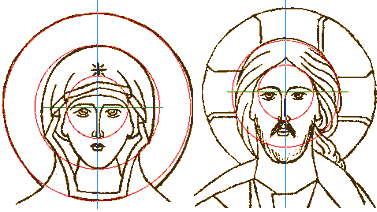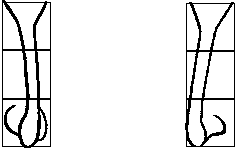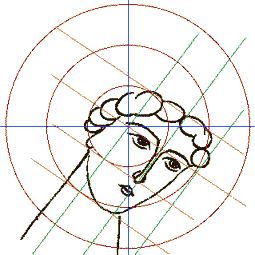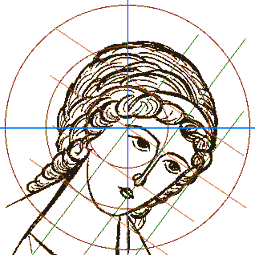 The eye is stylized and characterized by a slightly flattened pupil and iris. If this is over-emphasized the glance could become sinister. The drawing of the eyelids never touch one another at the corner of the eye. The upper eyelid must not be drawn too low or else the glance could express an exaggerated sadness. The iris is rendered as though suspended from the upper eyelid. The direction of the glance is emphasized by an off white crescent on only one side of the iris.
The eye is stylized and characterized by a slightly flattened pupil and iris. If this is over-emphasized the glance could become sinister. The drawing of the eyelids never touch one another at the corner of the eye. The upper eyelid must not be drawn too low or else the glance could express an exaggerated sadness. The iris is rendered as though suspended from the upper eyelid. The direction of the glance is emphasized by an off white crescent on only one side of the iris.
 Its length is the basic unit of measurement in the construction of the face. This measure is referred to as a module. The nose is rendered as fine and elongated. It is the axis of the face. The bridge of the nose is drawn in a triangular form and the tip is rounded.
Its length is the basic unit of measurement in the construction of the face. This measure is referred to as a module. The nose is rendered as fine and elongated. It is the axis of the face. The bridge of the nose is drawn in a triangular form and the tip is rounded.
The mouth is drawn small and fine and the upper lip narrower than the lower. The lower lip is lightened and will receive a layer of very transparent red.

![]() The ears are slightly shorter than the nose, they too are stylized and always represented at least the lobe showing (as in the case of the bonnet of the Mother of God for example). They follow the natural curve of the head and should not appear to be detached from the head.
The ears are slightly shorter than the nose, they too are stylized and always represented at least the lobe showing (as in the case of the bonnet of the Mother of God for example). They follow the natural curve of the head and should not appear to be detached from the head.
To draw a full frontal face properly it is necessary to know precisely the length of the nose. Then, using a compass, draw a circle the radius of which is equal to this length. Then, another circle is drawn having the same center but whose radius is twice that of the first. Finally a third circle is drawn which is three times the radius of the first. The second circle will approximately determine the size of the head, and the third indicates the halo. The halo won't be perfectly circular but will open slightly when reaching the shoulders. In fitting a face to a preexisting board, the process is worked in reverse beginning by drawing the triple radius circle and diminishing to the original nose radius.

Once the framework of the three circles and the module of the nose has been drawn, the icon painter must be free to follow the inspiration of the spirit and must not become a prisoner of the geometry. The painter will be drawn to a particular school or approach (Russian, Greek, Cretan...), and must train his vision in the particular school and avoid mixing styles.
The beginner will find below some aesthetic rules for the composition of a face that may help to give life to his work.

The direction in which the head is turned will dictate the position of the eyes. The eyes below presume the face is turned towards the right of the painter.


 To draw a three-quarters face properly, the artist must begin by tracing the three circles as in the drawing of a frontal face, determining the slope of the nose (and of the face) by tracing a tangent to the smallest circle.
To draw a three-quarters face properly, the artist must begin by tracing the three circles as in the drawing of a frontal face, determining the slope of the nose (and of the face) by tracing a tangent to the smallest circle.
Then parallels lines are drawn on both sides of this nose axis at a distance equal to one module. Finally, three perpendiculars lines that will establish the length of the face, of the nose and of the chin are drawn.
 The two larger circles are used to define the volume of the hair and the halo. In the case of the Mother of God and of the angels, the forehead is very low and the perpendicular top line is just a reference mark. In the drawing at the right the hair of the angel is shifted forward to suggest a movement of worship.
The two larger circles are used to define the volume of the hair and the halo. In the case of the Mother of God and of the angels, the forehead is very low and the perpendicular top line is just a reference mark. In the drawing at the right the hair of the angel is shifted forward to suggest a movement of worship.
![]()